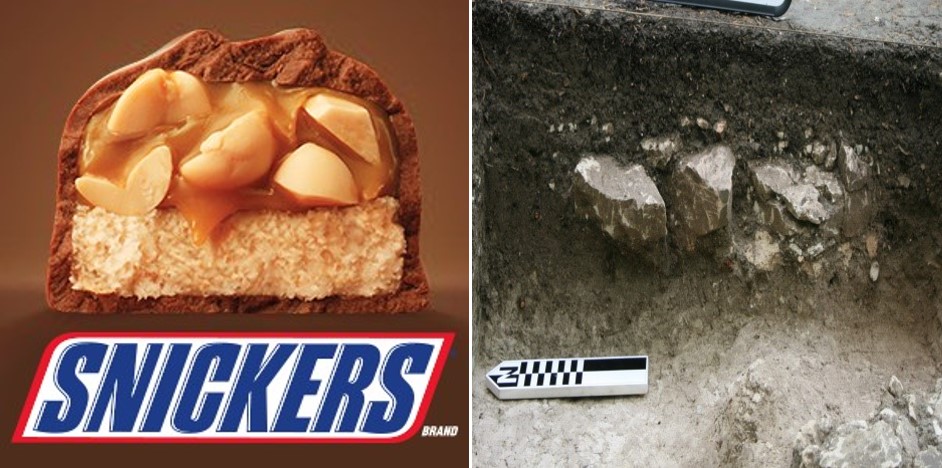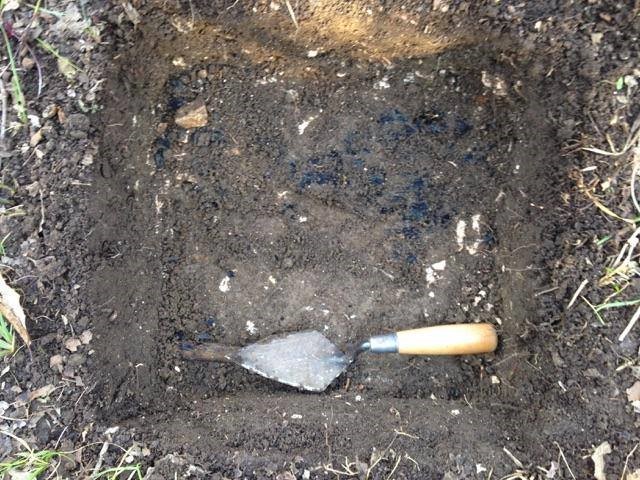by Natalie MooneyThis
is the second week of excavations for the 2017 Spring Field School. Currently
the group is excavating the holes for the informative panels at Fort Tombecbe.
Upon arrival at the site on Tuesday we finished screening the soil for Panel
Holes 1 and 2. Screening is important, because if we simply remove the soil from
these holes, even if it is nothing more than a shovel test, then we could
possibly miss artifacts. In Panel Holes 1 and 2 we
did not recover any artifacts, however during the excavation of Panel Holes 3
and 4 we found three different artifacts that all were from the nineteenth
century. In Panel Hole 3 we found a sherd from an
Albany slip stoneware vessel. At
this point we assumed that we found it in the second layer, because the topmost layer of soil at this site is mostly related to the mid-20th century campground. Archaeologists ascribe arbitrary names to the
different layers in soil. Each layer may have a different color, texture, or amount of artifacts, which depends on what sort of activities created that layer of soil. At Fort
Tombecbe, it is likely that the top layer will be dark loamy soil
with clay. In the second layer it will have more clay and chalk. The layers of soil at this site, also called stratigraphy, look remarkably like
a Snickers bar.

In Panel
Hole 4, contrary to our previous ideas, we found that the Albany slip sherd
most likely came from the top-most layer of soil. This is because we found a
sherd of the same vessel from that layer. In the second layer, named Layer B,
we found the third artifact of the day-- the base of a stoneware vessel that has a salt glazed exterior and an Albany slipped interior. That was all that was found in those layers. After that we dug Panel
hole 5, which is located in the moat of Fort Confederation. After the English
abandoned Fort Tombecbe in 1768, the Spanish eventually took over the fort in 1787.
They renamed it Fort Confederation and created large earthworks in order
to stop possible artillery from the Americans.
Outside of these earthworks they placed a moat in order to slow military
advancement. We did not reach the base chalk layer in this area. Reaching the
base chalk layer in any excavation is important, because that means there is no further human alteration to the soil. We left that hole unfinished for the rest of the
week until we can procure a 1-inch diameter soil corer explore more deeply. We received a visitor to the Fort
on Tuesday in the form of the illustrious Dr. Rob Riser, who was there to collect some of the wild garlic that grows in the fort.
On Thursday, we began excavation work on Panel hole 6. This is the first panel hole that is
officially inside of Fort Confederation. We were curious as to whether we would encounter remains of the
Spanish Blockhouse at this location, and it turns out we were correct in our assumptions.
Within a few digs of the shovel we ran into large amounts of charcoal. At this
point Dr. Dumas made an executive decision to excavate this panel hole as a
small excavation unit at 35 cm x 35 cm. We learned the technique to
create a perfect square for the unit. This is important because in Archaeology
there are grids we superimpose over the landscape to maintain the
context gathered from each unit as carefully as possible. Basically, in order to create a perfect square
you use right triangles. First, you make a line with pin flags the length and width you want to make your unit, which was in this case 35 cm. Then, you use the
Pythagorean Theorem to figure out the distance to the other corner, in this case 49.5 cm. Then you use the two rulers and make the
35 cm match with the 49.5 cm and place a pin flag there. Then repeat for the
other corner. In the excavation of Panel hole 6 we found interesting artifacts
and features, such as a burned board, which explains the charcoal. We also found
a healthy amount of metal artifacts such as nails. These artifacts and the
location that we were in the fort indicated that we likely had found a burned board of
the Spanish Blockhouse.

This discovery meant that for Panel Hole 7, we
needed to start it as an excavation unit. So we organized the unit with a
little trouble without help from Dr. Dumas, but we eventually sorted it out and
began excavating the unit. We did not dig deep enough to discover any artifacts before we had to
leave.